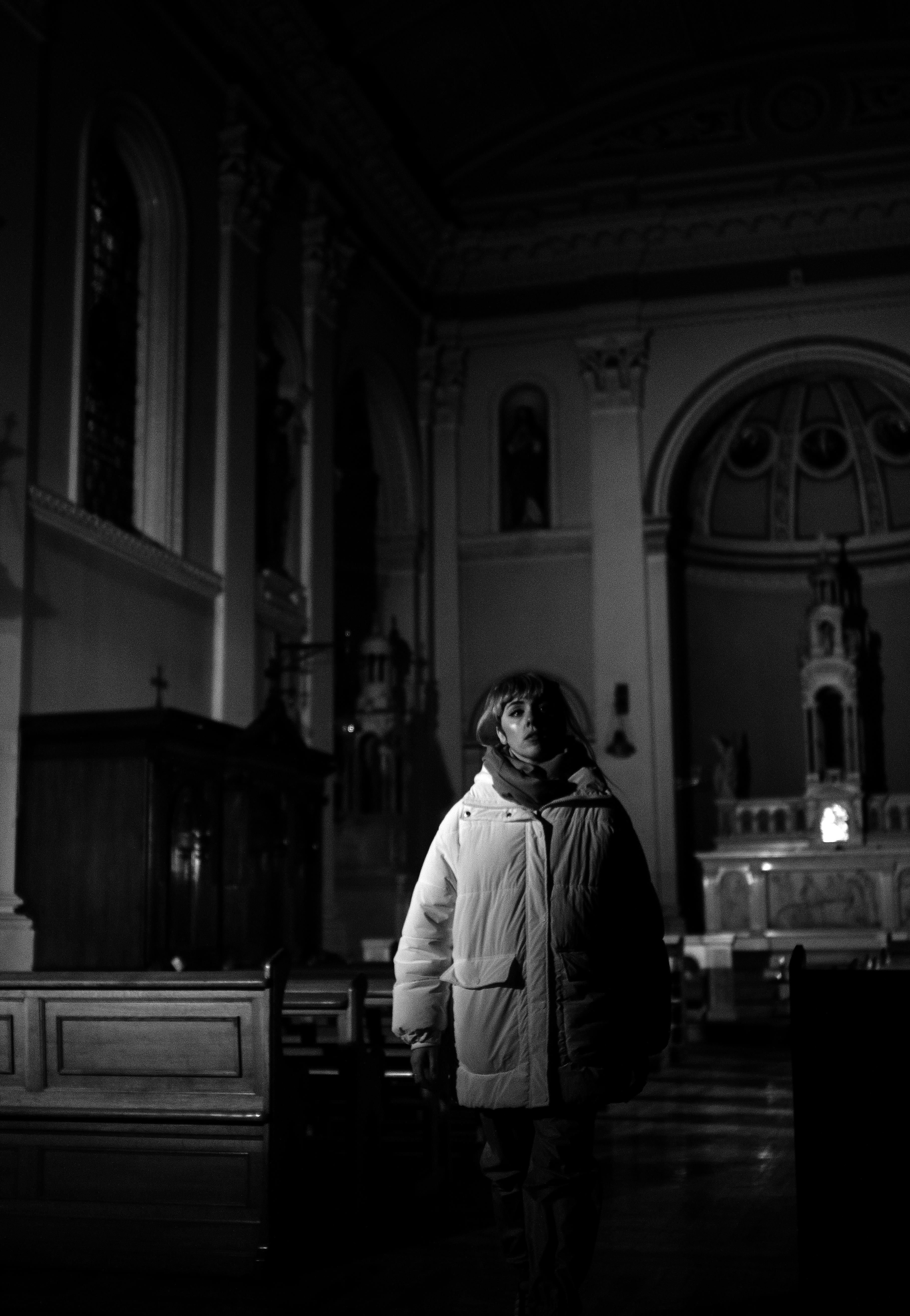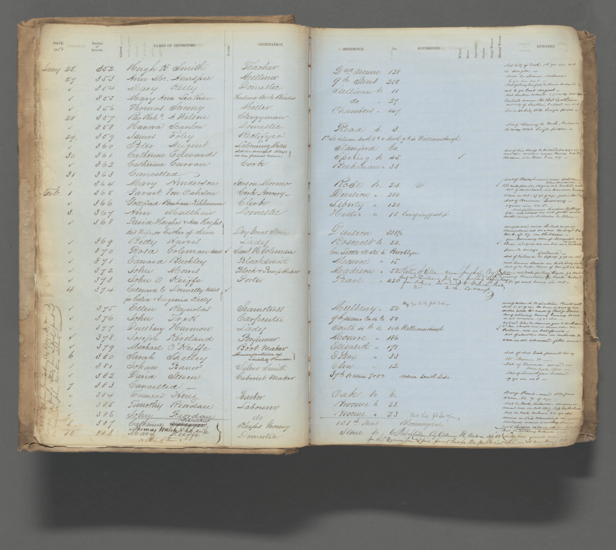“I’m from Napoli. Thank you for making a film about Napoli.”
Luke McManus’s “North Circular” is not about Naples, but recalling the comment made at a post-screening question and answer session, he said, “That was a beautiful thing to hear.”
The documentary film about Dublin’s North Circular Road “supports a good conversation afterwards,” the director said, and there’ll be several when it runs for a week at DCTV’s Firehouse Cinema, 87 Lafayette St., in New York City, from July 31. He and Annie Hughes, who at the very start of the 85-minute film, sings a song at the Cobblestone pub about political leader Charles Stewart Parnell, will be the panelists for some of them.
As to the Neapolitan’s view of his film, McManus said, “It’s not that it could be anywhere – it’s that there’s a specific type of place: disreputable, grungy, but sort of magnificent, and has dignity despite its decay.
“Port cities like Naples and Marseilles tend to have those energies, and parts of Berlin and parts of New York, even now.”
McManus spoke in similar terms when referring to the choice of black and white photography.
“I was talking to another filmmaker about the black and white effect,” he said. “It does create a dignity about an image. It elevates people within it.”
Its timelessness also allows story-telling without photographs or documents or newspaper clippings. “Is that then or now?” people will ask of a particular shot, but it’s always now.
The film’s foundation is an extended visual essay to which are added voices, music and other sounds, with the ultimate result being a “documentary musical,” to use McManus’s term.
The viewer gets to know something about the neighborhoods the road runs through and the various institutions nearby, such as the now-closed psychiatric facility St. Brendan’s Hospital at Grangegorman, Bohemian F.C., aka Bohs, based at Dalymount Park, Mountjoy Prison, the GAA’s headquarters Croke Park, and the chapel of the Gloucester Street Convent and Magdalene Laundry.
“I had always wanted to do a documentary about the North Circular Road,” said McManus, who moved into the Grangegorman neighborhood 20 years ago, “And I’d done a collaboration about the band Lankum that was in black and white and was very much in this esthetic world, and I wanted to do a longer-form version of that.

Detail of fountain and terraced housing at Blessington Street Basin in Phibsborough, off North Circular Road. [Photo by Patrick Jordan/Courtesy of Lightdox]
“But I hadn’t realized they were the same film,” he said of what became “North Circular.”
McManus was interested in the past worlds of Dominic Behan, the Behans’ uncle Peadar Kearney and Luke Kelly, but the struggle to save the Cobblestone pub in Smithfield became the focus. Rising stars of the folk revival like John Francis Flynn had made it their home, and then the news came that developers were intent on tearing it down to make way for a 9-story hotel on the site.
“It was nice to have that version of activism and music done by big hairy fellas of today,” McManus said with a laugh. “It was just falling in front of me. I just thought ‘How wonderful I’m getting to see something that is so vital and contemporary and topical.’
“But it also feels connected to the past, and that tradition of politics and music,” he added.
The North Circular Road is 3.5 miles long, but the film goes beyond the official address to take in the Wellington monument inside the Phoenix Park, on the west side, and continues past the Summerhill junction down to the dock on the east. It’s at these extremities that society’s disparities seem the greatest. O’Devaney Gardens is no longer there, it's been “obliterated,” and its tight-knit, often marginalized working-class community dispersed, while the grandeur of the Phoenix Park, which is home to the presidential residence Áras an Uachtaráin, remains.
On the east end, Sherriff Street hangs on, a stark contrast to the financial services industry centered near there. Singer Gemma Dunleavy describes as a “constellation” the homes of her uncles and aunts in the neighborhood. She tells of its history as a community of dockers and dressmakers and the story of her heroic great-grandmother. The Monto, the one-time red-light district, is part of the narrative.
Someone told McManus that the entrance to the Monto was very close to where soldiers picked up their wage packets. “You can imagine, the little brown envelope full of cash went into the pocket, but was soon spent,” he said.
The director is fascinated by the North Circular Road’s “contradictions” and its “competing tensions,” which include the British military presence. The army likely helped shaped the city’s culture in various ways, including its sense of humor, in his view.
It provided for young males from the poorest sections of the working class — one voice in the film says — with discipline, wages, sometimes housing, and a chance to see the world, a forerunner to the Irish military’s long participation in United Nations missions. But, of course, they were exposed to the real possibility of death or permanent disability, particularly in the years from 1914-18.
Gentrification is another tension and contradiction. Money is good, when before there was so little; as is progress. But for the young people who’ve remade themselves in the Cobblestone’s vibrant trad scene, the pub being gobbled up is not progress.
The musician Flynn says people refer to Stoneybatter being “mad posh” of late; and he clarifies for the record, “But I’m certainly not posh, and this house is certainly not posh.”
McManus said that many of the North Circular Road’s communities, such as Phibsborough, Stoneybatter and his own Granngegorman, are “democratic” and “exciting” with the original atmosphere intact and long-time residents co-existing easily with the newcomers.
A few years before he arrived, he became involved with the film industry. “I found myself producing a documentary at a young age and I thought, ‘This is good fun,’” he recalled.
“I had the most outrageous case of beginner’s luck,” he added, referring to “The Million Dollar Deal,” which was about professional poker players in Las Vegas. Several of them were from Ireland, including Donnacha “The Don” O’Dea, a swimmer in the 1968 Olympics and the only child of actors Siobhan McKenna and Denis O’Dea.
Two actors are part of the 1998 film, a sort of cult classic now that can be found on YouTube: the late John Hurt is the narrator and Matt Damon, a poker player in the movie “Rounders” from that time, makes a cameo appearance.
“North Circular” is McManus’s debut feature documentary as a director. “It’s the first time I came up with an idea and was really given the freedom to implement it, outside of the restrictions of TV.”
The Arts Council, he added, have a program, whereby “they give you an amount of money and let you at it. And they literally say, ‘don’t compromise, don’t do anything commercial and we’ll see you in 15 months.’"
Starting out, he felt, “I don’t have to fight a losing battle with people who want something more conventional.”
McManus said, “There is an appetite for distinctive and particular takes on things. Something like ‘An Cailín Ciúin’ has done filmmakers a huge favor in that [it shows] you can make a commercial success out of something very simple and subtle and slow, if it’s done to a high enough standard, and if it resonates with people emotionally.”
McManus and his film have been winning plaudits at home and in Europe. In this country, “North Circular” won the American Cinematographer Award for Cinematography at the Salem Film Festival in Salem, Mass.
Stephen Pizzello, who is editor-in-chief of American Cinematographer Magazine and who selected the film for the award, commented: “‘North Circular,’ directed by Luke McManus and shot by a clearly skilled team of cinematographers (McManus, Evan Barry, Jamie Goldrick, Patrick Jordan and Richard Kendrick, with additional camerawork by Alex Sapienza and Thomas Beug), presents a stunning array of black-and-white images framed in the boxlike 1.33:1 aspect ratio.
"Bold framing of the doc’s settings result in striking compositions throughout this documentary,” he added. "The images have a truly cinematic quality that occasionally recall black-and-white 'kitchen sink' films of the 1960s, or even film noir. North Circular presents a consistent cavalcade of shots and compositions that boast an aesthetically impressive ‘wow’ factor.”
McManus said of the documentary’s narrative, “We brought together a load of threads [including boxer Kellie Harrington’s Olympic homecoming, a Dunleavy concert and the Cobblestone’s reprieve], which give it an energetic ending that, I think, has been a big part of the film’s success.
“I think it’s fine to bring people to the dark tunnel as long as there’s a way out,” McManus said. “Nobody needs to be depressed by a night in the cinema.”
Most everyone who’s appeared in the film has seen it and liked it. Quite a few went twice and have participated in Q & As afterwards.
McManus was worried about one participant, however -- tin whistler Seán Ó Tuama, who with two others, Flynn and Dunleavy, is listed in both the “Voices” and “Musicians” sections of the credits.

Luke McManus is the director, writer and co-producer of “North Circular.” [Photo by Killian Broderick]
You know you are in Dublin when someone greets you with a cheerful “There you are!” That’s Ó Tuama’s way and his verbal engagement, then, is usually a form of banter also identifiable to the city.
His is a sad story, though. Just when he was “dreaming of Paris,” at age 19 in 1980, he was taken away to a psychiatric ward at Grangegorman, where he was administered a “miracle drug.” He was there a long time, he says. But perhaps the defining moment of Ó Tuama’s life was his witnessing a tragic event involving two close family members.
His nephew, whom McManus knows, told him following a screening, “I think it’s fantastic, but it’s a hard watch for us.”
“I went up to Seán’s place,” the director recalled. “I said to him, ‘Do you want to watch the whole film?”
“Just my bit” was the answer.
After it was over, there was silence for about 10 seconds. And then Ó Tuama turned round in his chair and said to McManus, “It’s an excellent production – you’ve captured me perfectly!”
For tickets and times for the New York run, click here. For an Irish Echo review, click here. To view the trailer, see below:









